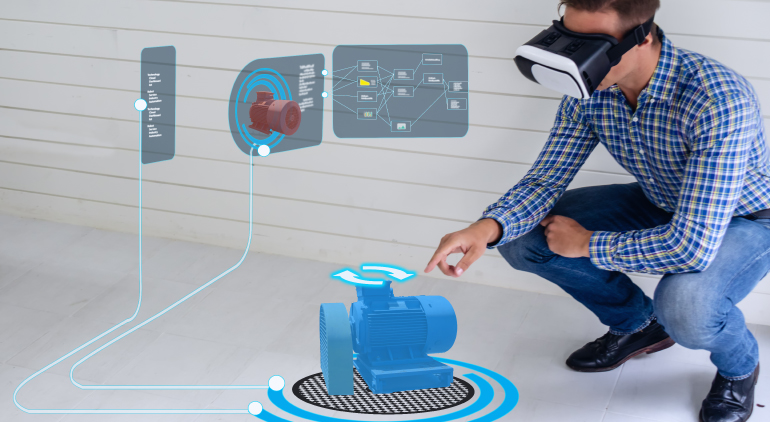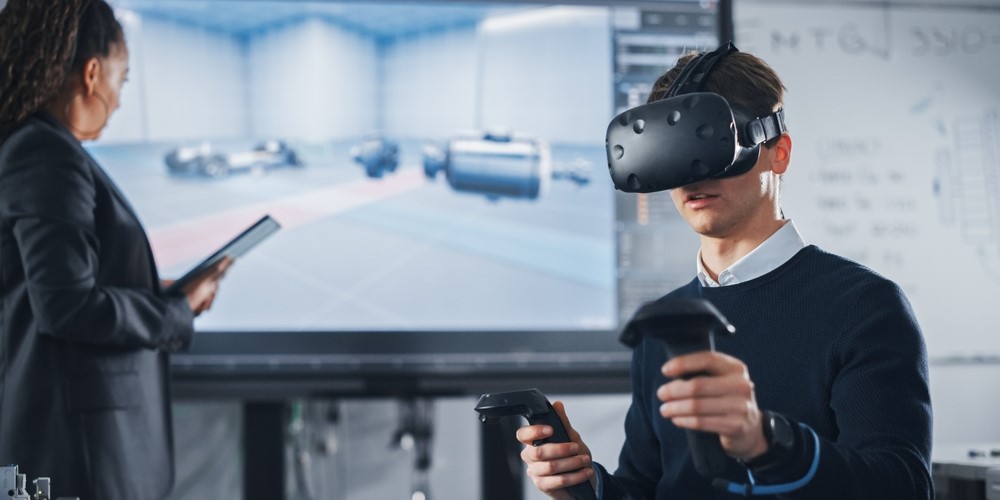Virtual Reality in Engineering Education

VR provides a wide array of solutions for engaging the students in more hands-on educational methods. Before diving into the benefits that VR poses for engineering education, let us take a look at some global numbers.
According to Fortune Business Insights, the global virtual reality powered education market will reach a value of $13,098.2 Million by 2026.
The market will exhibit a CAGR of 42.9% from 2021 to 2026.
Going by the market trends, this is largely fuelled by the need for remote education amid the pandemic. This could sustain into the future due to the accessibility and enhanced functionality that VR has exhibited currently. Let us understand the viability of virtual reality and virtual engineering in engineering education.
Benefits of VR Education for Engineering Students

Applications around the world has shown 6 crucial benefits from the students’ standpoint. We will list these down initially before understanding some use cases.
1) Tackle real life challenges by developing autonomous problem solving skills.
2) Develop an ability to share technical information and complex real-life situations with professionals and team members without any actual on-field experience.
3) Ability to examine problems from multiple robust standpoints. This stems as a benefit from knowing the exact working of any particular systems and not just the input and output sections.
4) Innovative tech allows a chance for insightful creativity.
5) Arrive at the most apt engineering options, solutions, and decisions with a holistic understanding of each subject.
6) Be more practical in terms of business viability of certain solutions and to propose innovative, data and knowledge driven alternatives to specific tasks.
Now that the benefits have been elaborated, let us take a look at some examples of how this can be achieved.
Engineering Education Through VR: a Use Case
To get a better understanding of how the benefits stem from VR, let us look at a core concept of Engineering and the feasible VR alternatives to teaching those concepts.
✔️ Thermodynamics
According to research by the University of Detroit Mercy, undergraduate students faced difficulties learning the basic laws of thermodynamics.
Misconceptions arise among students pertaining to heat, energy, isothermal processes, cyclic process, and rate and amount among a plethora of others.
NCEES has estimated student performance to be between 40% and 65% when it comes to Thermodynamics. So how does VR address this?
✔️ Thermodynamics Through VR
Let us take the example of a Jet Engine. It is a practical, industrial application of thermodynamics on a holistic level. Let us understand how VR familiarizes students with the intricate sciences and the paramount variables in between.
VR can sport a scientifically accurate 3D model of a jet engine. This sort of accuracy is difficult to obtain in a traditional environment of rote learning.
 Get the App from Meta Store: Download Now
Get the App from Meta Store: Download Now
How VR Enhances the Learning Experience
The minutest of components can be studied by the students in this immersive environment.
They can interact with any part of the engine, experiment with the positioning, and understand the functionality better.
They are practically engaging with an actual jet engine but without the consequences or financial restraints of owning one.
With the dismantled view or an x-ray feature, a student can understand each part and a component of the engine and the overlaid text boxes provide ample information.
The immersive environment can also sport theoretical concepts and teach them through insightful graphs (for instance a Brayton Cycle through a P-v graph).
Virtual engineering education addresses the central issue of the limitations of diagram based classroom learning.
It also engages the students in a more meaningful manner, thus polishing the overall excitement associated with the learning outcome.
Now that the students are happy, let us conclude by understanding how this benefits the institution.
"Step into the future of engineering training with iXR labs' cutting-edge VR module, where complex concepts leap off the page and into your hands."
Benefits of VR Adoption for the Institution
Limit the asset-acquiring costs. With a one-time installation, a plethora of devices, virtual labs and other training equipment can be set up. It also expands the possibilities.
Glancing at the example above, it might be an improbable task to get your hands on an actual, industry-grade jet engine. Through VR, this limitation is addressed and solved.
Reduce risk. Through the immersive VR environment, real-life scenarios can be recreated in a consequence-free, yet meaningful manner.
Inaccessible or restricted locations such as reactors can be explored without any limits.
Mistakes may cost more than marks. Especially in engineering education, faulty handling of certain apparatuses or substances could lead to environmental harm or prove fatal for the learner. VR completely eliminates this.
The institution’s distance learning program can be enriched as much as the on-site program by integrating virtual labs and virtual machines.
Conclusion
The gross enrollment for higher education in India is 26% according to Financial Express. This points at a need for infrastructural enhancement.
Financial Express also estimates that unemployability looms large among the 1.3 Million engineers graduating annually in India. This can be a result of minimal experience when it comes to application of the academics into real world situation. This is where virtual reality comes in.
By enhancing student motivation, permitting experiential learning, promoting actual tech use and exploration, and by encouraging active participation, VR can definitely amplify understanding and application of core engineering concepts, paving way for better equipped and smarter graduates.
When it comes to the application of virtual reality in higher education, iXR Labs take the lead. Our groundbreaking tech and innovative applications are simply game-changers in this business. To know more, visit us at www.ixrlabs.com.




